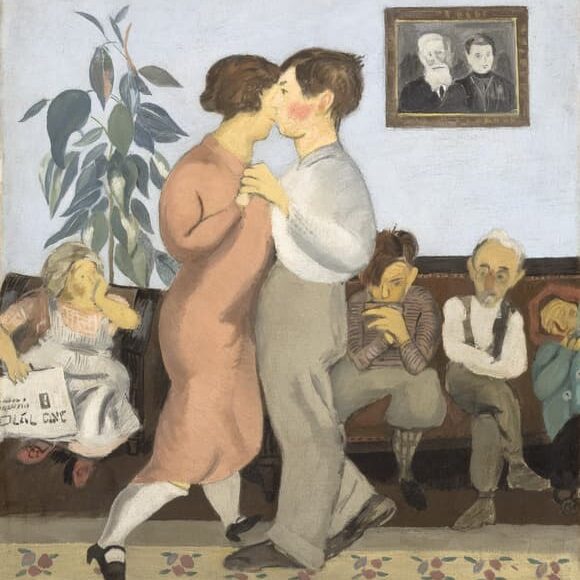Claire Fontaine Launches Contemporary Art Series in Museum Lobby

Installation Evoking Immigrant Experience Is First Offering of New Series Using Walls, Floors, and Ceilings
New York, NY – Beginning November 8, the Jewish Museum will launch a new series showcasing contemporary art in its Skirball Lobby. Artists will be invited to create new work or adapt a recent piece for the Museum’s spacious entryway. The first installation in the new series, Tears, is a work by French artist Claire Fontaine consisting of nine neon signs suspended from the ceiling, each reading “Isle of Tears” in a different language. The work is inspired by the experiences of immigrants passing through Ellis Island – which was often referred to as the “Isle of Tears” – to enter the United States. Using Walls, Floors, and Ceilings builds on the Museum’s 1970 program called Using Walls that featured the work of 14 up-and-coming international artists of the time including Richard Artschwager, Sol Lewitt, and Lawrence Weiner, among others. Now, nearly 45 years later, the Jewish Museum is revisiting this innovative moment in its history with a new series of artist commissions, showcasing new or adapted work by artists from around the globe. In May 2014, the series will feature the work of Mel Bochner, who participated in the 1970 Using Walls program, timed to his solo exhibition at the Museum. Claire Fontaine: Tears remains on view at the Jewish Museum through April 20, 2014.
The gateway to a new life, Ellis Island became a place where old identities were left behind in favor of a new American self. Claire Fontaine draws on French filmmakers Georges Perec and Robert Bober’s 1979 book and film Récits d’Ellis Island. Perec and Bober interviewed the last surviving immigrants and documented their experiences, finding that although people arrived from many different countries, their stories were similar. The neon signs present translations of “Isle of Tears” in French, Polish, Russian, Yiddish, Greek, Italian, and German, in addition to Spanish and English. These were the languages most commonly spoken at the Ellis Island immigration station by the people who came to America through its doors-nearly sixteen million between 1892 and 1914.
The neon lights, in lambent blue and green hues, create a wavelike color field above the spectator. Located in the lobby-the liminal space between the outside world and the realm of art-they mark a point of transition for the visitor. With their multilingual voices they serve as surrogates for the millions of poor immigrants who landed at Ellis Island filled with hope and trepidation.
Based in Paris, the collective Claire Fontaine was founded in 2004. She appropriated her name from Clairefontaine, a brand known across France for its line of school notebooks and stationary. The artist explores socio-economic and cultural concepts of power and freedom, often suggesting the falsehood of such notions. Through a range of media – video, painting, text, and sculpture – Fontaine seeks to address the ethical crises and political plight affecting our society, offering her art as a portal to understanding the possibility and optimism for change.
Claire Fontaine lives and works in Paris, France. She has exhibited her art around the world including Tate, London; Museo Tamayo, Mexico City; the Museum of Contemporary Art, North Miami; and CCA Wattis Institute for Contemporary Arts, San Francisco.
In May 1970, the Jewish Museum presented Using Walls, an exhibition of commissioned projects installed both within and beyond the gallery space of the Warburg Mansion. A former residence, the Museum renovated the French Gothic chateau-style building in the early 1960s and expanded its gallery space by adding new, modern galleries and an outdoor sculpture court to accommodate the larger scale works created by artists in the postwar era. Using Walls (Indoors) focused on the sentiment that the wall was not merely a structure or surface but could function as a material or component of a work of art. This philosophy extended to Using Walls (Outdoors) with emphasis placed on the relationship between art, public space, and the viewer. Using Walls (Indoors) featured innovative works by 14 international artists such as Sol Lewitt, Robert Ryman, Richard Tuttle, Mel Bochner, Richard Artschwager, and others. Using Walls (Outdoors) focused on the work of City Walls, Inc. and Smokehouse Associates, two collectives known for their large-scale, vibrant murals in unexpected places across New York City.
The new Using Walls, Floors, and Ceilings series is organized by Jens Hoffmann, Deputy Director, Exhibitions and Public Programs, and Joanna Montoya, Neubauer Family Foundation Assistant Curator.
The Jewish Museum is grateful to Claire Fontaine and her assistants Fulvia Carnevale and James Thornhill for participating in The Jewish Museum’s inaugural Using Walls, Floors, and Ceilings exhibition. The Museum extends special thanks to the Berezdivin Collection, San Juan, Puerto Rico and Metro Pictures, New York for their enthusiasm and kind support of this exhibition.
Press contacts
Anne Scher, Molly Kurzius, or Alex Wittenberg
The Jewish Museum
212.423.3271 or [email protected]













